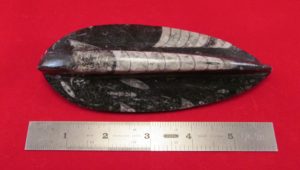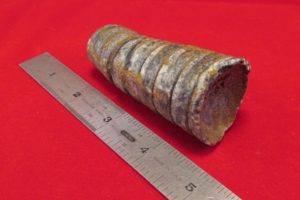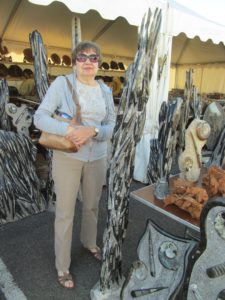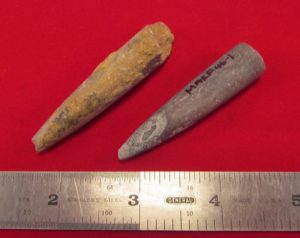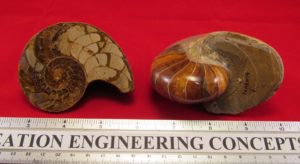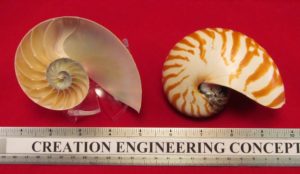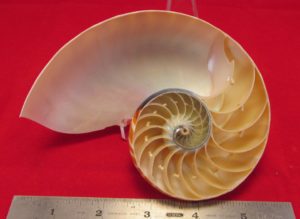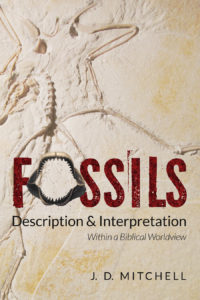All fossil images and descriptions ©2017 all rights reserved. Contact us for permission policy.
Nautiloid Orthoceras
Description: The main center specimen of Orthoceras is 1/2″ diameter X 4″ long and eight septa are visible. The partial specimen at the top edge represents an animal with a shell that was at least 3/4″ diameter. The matrix is 2 1/8″ wide X 5 3/4″ long X 1 1/8″ thick. A number of other nautiloid fragments of various sizes and orientations are also visible in the matrix.
Location: From the Sahara Desert in Northern Morocco.
Interpretation: The Orthoceras and other similar fossil nautiloid shells were shaped like a tapering cylindrical cone and had numerous concavo-convex chambers like today’s chambered nautilus. They have never been found in today’s oceans and are thought to be extinct. Just like spiral nautiloids they must have had heads with eyes and grasping tentacles. Orthoceras are found in massive fossil graveyards in Morocco and workers there shape and polish them into all sorts of artistic items for sale. Because of their beauty, they are very commonly found for sale in rock and fossil, jewelry, and other specialty shops all over the world. It is amazing that fossilized sea creatures such as Orthoceras are found in the Sahara Desert. This fact indicates that the area has not always been dry and nearly covered with sand as it now is. Those facts mesh with the biblical creationist expectation of massive changes to the earth’s surface being a result of the Genesis Flood.
#MARF13
Description: The Orthoceras section is 1 3/8″ diameter on the large end X 15/16″ diameter on the small end X 3 1/8″ long. There are 8 1/2 chamber sections in the fossil. On the large concave end can be seen remnants of the siphuncle that ran up the center of the animal. The shell looks to be made up of uniformly spaced concavo-convex chambers.
Location: Morocco.
Interpretation: Since Orthoceras is extinct, any assumptions about how they lived must be made on incomplete evidence. It can be assumed that the animals that lived in the shells (the phragmocones) were likely similar in design, appearance, and complexity to the nautilus of today. Since the Orthoceras fossils are cone shaped we can guess that the animal lived in the large end and swam be ejecting water out that end. That indicates the animal probably moved mostly horizontally in the direction of the small end. The Moroccan-found Orthoceras fossils are usually a maximum length of about 12 inches. The loose out-of-matrix Orthoceras specimens like the one above, tend to break apart at the chamber joints so that complete fossilized animal shells are rare.
#MARF39
Description: The artistic slabs consisting of hundreds of Orthoceras nautiloids behind and to the left of the lady are up to seven feet long. The nautiloids are consistently oriented parallel to each other indicating a common direction of travel when they were rapidly buried.
Location: Morocco.
Interpretation: How can the usual orientation and condition of these fossil nautiloids by the billions be logically explained using secular presuppositions? The answer is that they cannot!
In the Grand Canyon, “billions of large fossilized orthocone nautiloids are entombed in a six foot layer near the base of the massive Redwall Limestone formation. This extraordinary layer persists throughout the Grand Canyon region, northern Arizona and southern Nevada. The fossil bed occupies an area of at least 5,700 square miles and contains an average of one fossilized nautiloid per square yard.” (Vail, Tom, Grand Canyon – a different view, Master Books, 2003, p. 52.)
The evidence provided by these nautiloids in Morocco and the Grand Canyon area screams of catastrophe unlike any of the natural events we see today. The global Genesis Flood is the only logical explanation for the Orthoceras massive graveyards!
Belemnite Guards
Description: Guard segment to the left is 2 1/2″ long X 1/2″ diameter maximum. Right guard is 2 1/4″ long X 1/2″ diameter. The right hand specimen exhibits a furrow along one side that is characteristic of many belemnite fossils.
Location: Black Ven marl of Lyme Regis, Dorset, United Kingdom.
Interpretation: Belemnites are now-extinct cephalopods similar in design to the living squid, cuttlefish and octopus. They had bullet-like internal skeletons called guards that are the usual parts found fossilized in sedimentary rock worldwide. It is thought that the guards served as ballast for the animals.
Squids possess an internal support called a pen made of chitin. In belemnites the internal support (guard) is made of calcium carbonate. Both animals were wonderfully designed by the Engineer of the universe. Perhaps belemnites went extinct because they were unable to survive the conditions created by the cataclysmic Genesis Flood.
#MARF46
Nautilus Cenoceras
Description: The sliced Cenoceras fossil on the left is 3 5/8″ wide X 3″ high X 1 1/8″ thick maximum. There are 38 countable concavo-convex chambers connected by a siphuncle running through the center of the chambers. The largest (last) chamber is 3/8″ wide X 1 7/16″ long. The last living chamber was broken away and is not present in this fossil. The whole Cenoceras fossil to the right is 3 3/4″ wide X 3″ high X 2 5/8″ thick. Both fossils are very similar in size.
Location: Both fossils are from Madagascar.
#MARF18, 14
Description: The extant cut and whole chambered nautilus shells above are about the same size (4 1/8″ wide X 3 1/8″ high X 2 1/8″ thick). There are 23 countable concavo-convex chambers in the cut specimen. These extant shells have the same involute shell spiral form as do the fossil specimens.
Description: Another extant sliced chambered nautilus shell where the siphuncle path can be clearly seen.
Interpretation: Since the terminal living chamber of the cut fossil Cenoceras above is broken away it represents a living animal quite a bit larger than the two extant shells in the photo below the fossils. There is no significant difference in design between the Cenoceras and the chambered nautilus. Therefore, Cenoceras is another example of a living fossil, and these specimens were rapidly buried in the Genesis Flood some 4,500 years ago.
ORDER THE FOSSIL BOOK:
